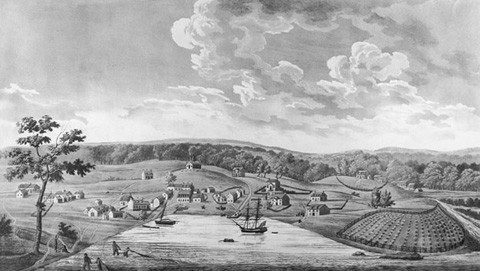
Daniel Bowley, Esq., Baltimore in 1752, From a Sketch Made by John Moale, Esq., Baltimore, Maryland, 1817. Aquatint. 19 1/2" x 29". (Courtesy, Old Salem Inc; Museum of Early Southern Decorative Arts.)
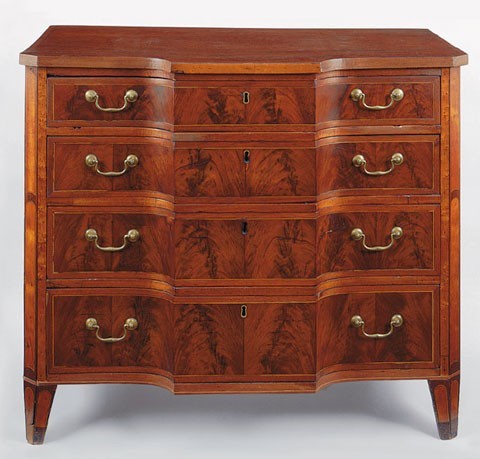
Chest of drawers attributed to Bankson and Lawson, Baltimore, Maryland, 1785–1792. Mahogany and mahogany, maple, and satinwood veneer with tulip poplar and yellow pine. H. 34 3/4", W. 40 1/2", D. 22 1/2". (Private collection; photo, Gavin Ashworth.)
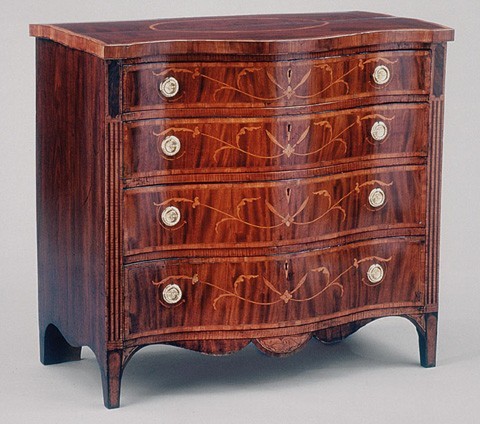
Chest of drawers attributed to Bankson and Lawson, Baltimore, Maryland, 1785–1792. Mahogany and mahogany, maple, and satinwood veneer with tulip poplar, white pine, and yellow pine. H. 36 1/4", W. 39 1/4", D. 22 1/8". (Courtesy, Colonial Williamsburg Foundation; photo, Hans Lorenz.) The inlay woods used by this shop include mahogany, maple, satinwood, rosewood, tulip poplar, and boxwood.
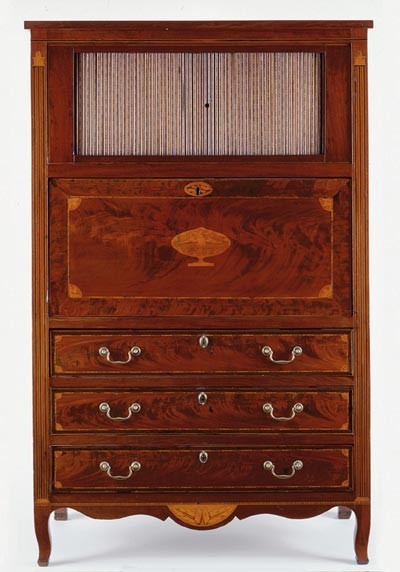
Secretaire à abattant attributed to Bankson and Lawson, Baltimore, Maryland, 1785–1792. Mahogany and mahogany veneer with tulip poplar and yellow pine. H. 63 1/4", W. 40 3/8", D. 17 1/4". (Courtesy, Chrysler Museum of Art, Moses Myers House; photo, Gavin Ashworth.)
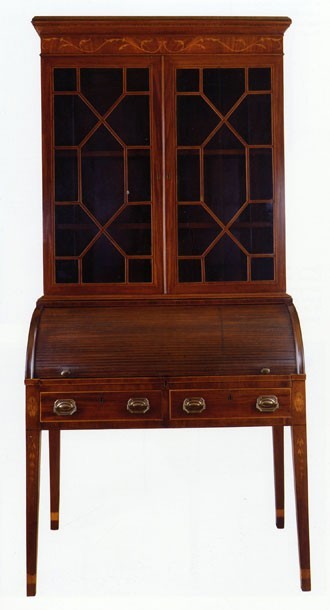
Writing table and bookcase attributed to Bankson and Lawson, Baltimore, Maryland, 1785–1792. Mahogany and mahogany veneer with tulip poplar and yellow pine. H. 83 1/4", W. 40 1/2", D. 24". (Private collection; photo, Gavin Ashworth.) This writing table and bookcase reportedly descended from Nicholas Rodgers of Druid Hill in Baltimore.
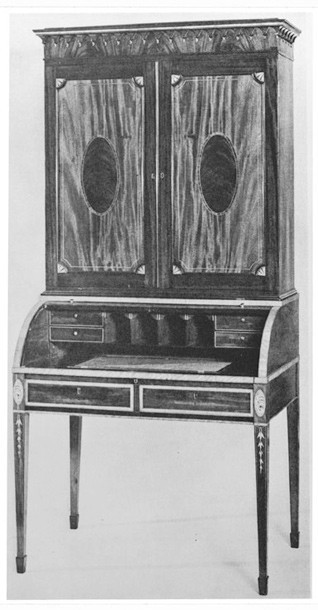
Writing table and bookcase attributed to Bankson and Lawson, Baltimore, Maryland, 1785–1792. Mahogany and mahogany veneer with tulip poplar and yellow pine. H. 83", W. 41 1/2", D. 24". (Private collection, location unknown.)
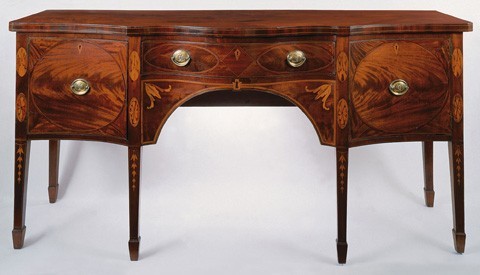
Sideboard attributed to Bankson and Lawson, Baltimore, Maryland, 1785–1792. Mahogany and mahogany veneer with tulip poplar and yellow pine. H. 37 1/2", W. 76 1/2", D. 25 3/4". (Private collection; photo, Gavin Ashworth.)
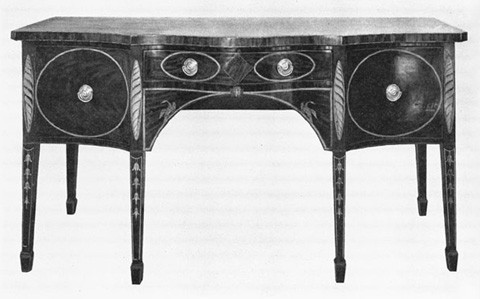
Sideboard attributed to Bankson and Lawson, Baltimore, Maryland, 1785–1792. Mahogany and mahogany veneer with tulip poplar and yellow pine. H. 39 1/2", W. 79", D. 26". (Private collection, location unknown.) The shells on the upper leg stiles are exceptionally large.
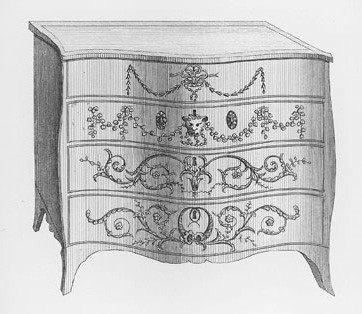
Design for a “Commode Dressing Table” illustrated on plate 77 of George Hepplewhite’s Cabinet-Maker and Upholsterer’s Guide (1788). (Courtesy, Winterthur Museum.) The second and third editions of Hepplewhite’s design book appeared in 1789 and 1794, respectively.

Design for a “Tambour Writing Table and Bookcase” illustrated on plate 69 of George Hepplewhite’s Cabinet-Maker and Upholsterer’s Guide (1788). (Courtesy, Winterthur Museum.)
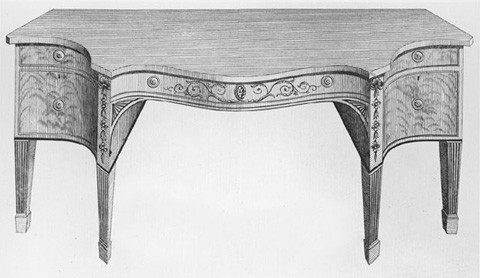
Design for a “Side Board” illustrated on plate 30 of George Hepplewhite’s Cabinet-Maker and Upholsterer’s Guide (1788). (Courtesy, Winterthur Museum.)

Design for a “Serpetine Front Celleret Sideboard” illustrated on plate 4 of the Society of Upholsterers’ Cabinet-Makers’ London Book of Prices (1788). (Courtesy, Winterthur Museum.) The second and third editions of this publication appeared in 1793 and 1803, respectively. George Shearer provided the design for this sideboard.
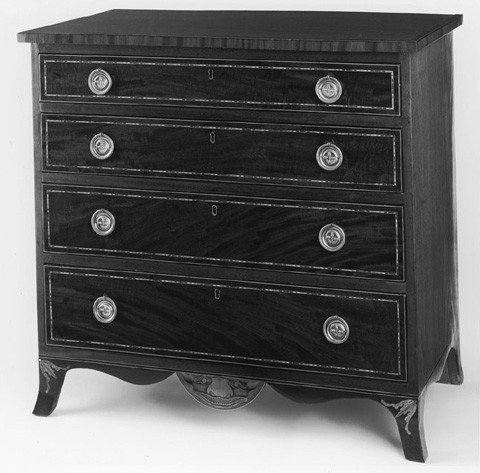
Chest of drawers attributed to Bankson and Lawson, Baltimore, Maryland, 1785–1792. Mahogany and mahogany veneer with tulip poplar and yellow pine. H. 35 7/8", W. 37 1/8", D. 20 3/4". (Collection of Stiles Tuttle Colwill; photo, Gavin Ashworth.)

Detail of the inlay on the skirt of the chest illustrated in fig. 13. (Photo, Gavin Ashworth.) Although the grotesque is extremely graphic, it is comprised of a small number of individual pieces. Its visual complexity is the result of careful shading with hot sand. Using this technique, the inlay maker gave the grotesque’s forehead, ears, eyes, and cheeks a three-dimensional quality rarely seen in American inlay.
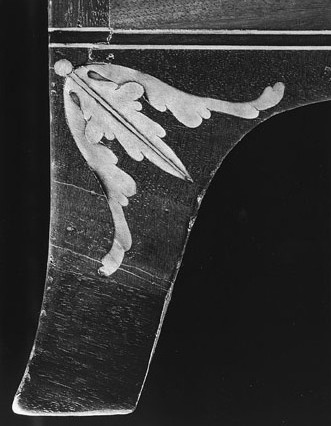
Detail of the inlaid husk on the left foot of the chest illustrated in fig. 13. (Photo, Gavin Ashworth.) The husks are made in three pieces. The components on either side of the shaded central spine were stacked and then sawn to shape, rather than being cut out individually. The shaded central spine dividing each half is a separate piece. Numerous variations of this design occur on other pieces attributed to Bankson and Lawson.

Detail of the inlay on the drawers of the chest illustrated in fig. 3.

Detail of the case construction of the chest illustrated in fig. 2. (Photo, Gavin Ashworth.)
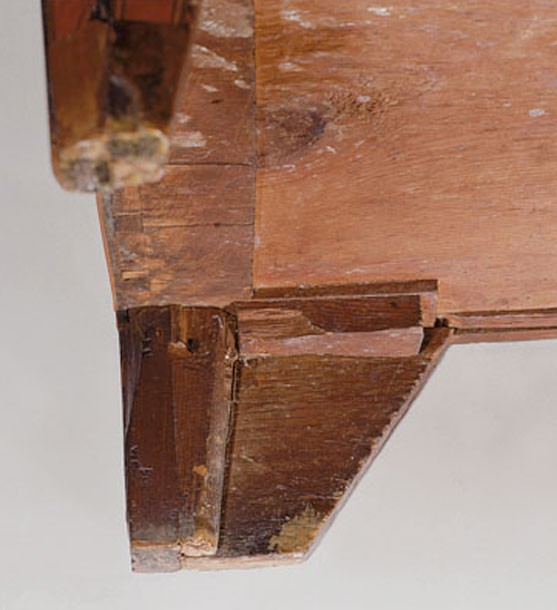
Detail of the base and foot construction of the chest illustrated in fig. 2. (Photo, Gavin Ashworth.)
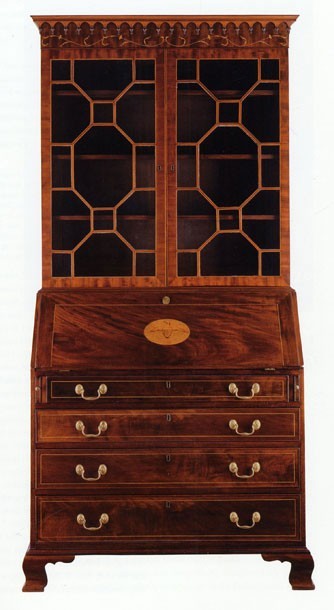
Desk-and-bookcase attributed to Bankson and Lawson, Baltimore, Maryland, 1785–1792. Mahogany and mahogany veneer with tulip poplar and yellow pine. H. 86", W. 41 1/2", D. 21 1/4". (Private collection; photo, Gavin Ashworth.)
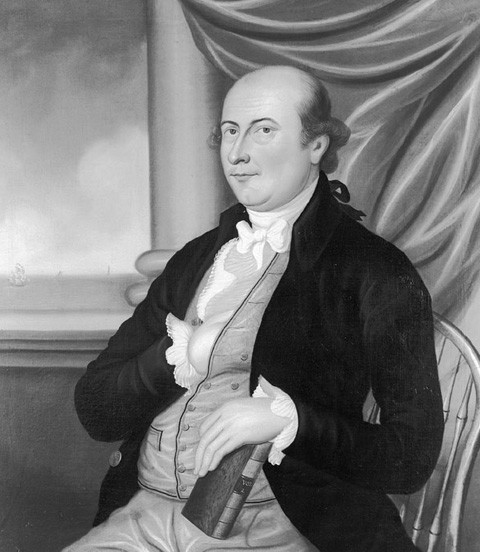
Charles Peale Polk, Richard Lawson, Baltimore, Maryland, 1794. Oil on canvas. 37 1/2" x 33 1/2". (Courtesy, Maryland Historical Society.) The painting is signed and dated on the reverse: “Chas. P. Polk pinxt Baltimore, Maryland, November, 1794. Richard Lawson, son of Stephen and Agnes Lawson, born 25 December 1749 at Keigby, Yorkshire, England.”

Desk-and-bookcase, probably coastal South Carolina, ca. 1790. Mahogany and mahogany veneer with cypress. H. 96 1/4", W. 41 1/4", D. 21 1/8". (Private collection; photo, Gavin Ashworth.)
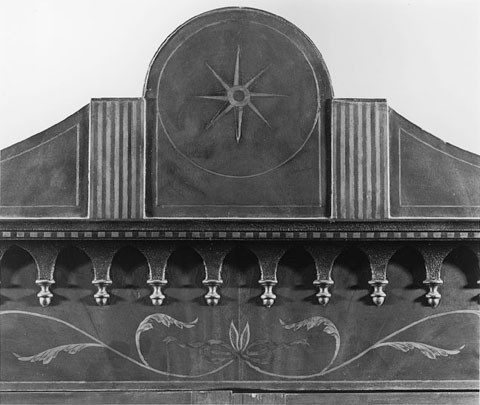
Detail of the inlay on the pediment of the desk-and-bookcase illustrated in fig. 21. (Photo, Gavin Ashworth.)

Secretary-and-bookcase, Charleston, South Carolina, c. 1790. Mahogany and mahogany veneer with pine. Dimensions not recorded. (Private collection; photo, Gavin Ashworth.)

Detail of the inlay on the frieze of the desk-and-bookcase illustrated in fig. 21. (Photo, Gavin Ashworth.)
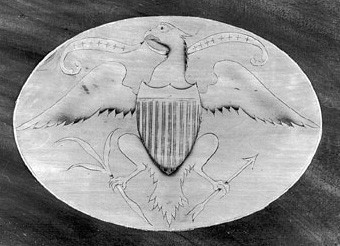
Detail of the eagle inlay on the fallboard of the desk-and-bookcase illustrated in fig. 19. (Photo, Gavin Ashworth.)
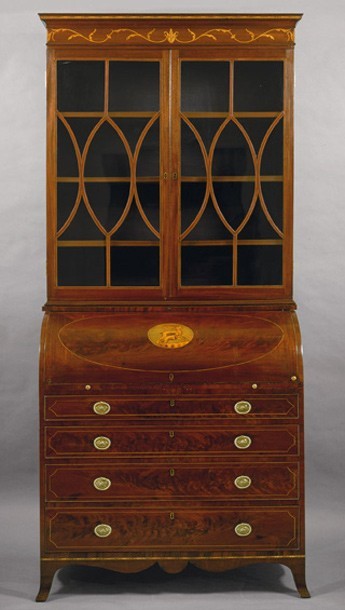
Desk-and-bookcase attributed to Bankson and Lawson, Baltimore, Maryland, 1785–1792. Mahogany and mahogany veneer with tulip poplar and yellow pine. H. 89", W. 42 1/2", D. 20 1/2". (Private collection; photo, Joel Breger.) The mullion arrangement on the bookcase appears related to that of a “Secretary and Bookcase” illustrated on plate 43 of George Hepplewhite’s Cabinet-Maker and Upholsterer’s Guide (1788).

Detail of the stag and hound inlay on the cylinder of the desk-and-bookcase illustrated in fig. 26.
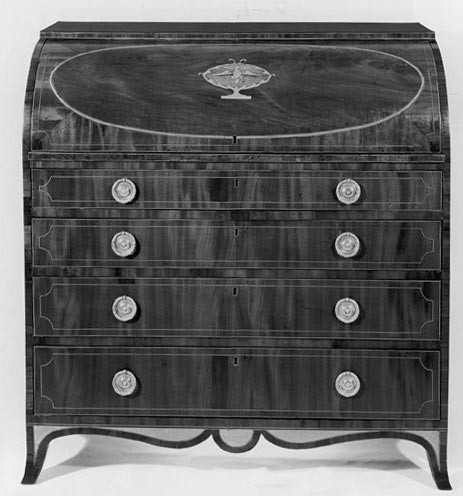
Desk attributed to Bankson and Lawson, Baltimore, Maryland, 1785–1792. Mahogany and mahogany veneer with tulip poplar and yellow pine. H. 44 1/2", W. 42 1/2", D. 20 1/2". (Courtesy, Sack Heritage Group.) www.sackheritagegroup.com
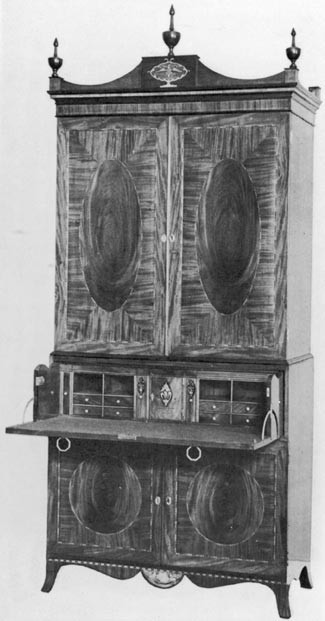
Clothespress with secretary drawer attributed to Bankson and Lawson, Baltimore, Maryland, 1785–1792. The current location of this piece is not known. It was illustrated in Parke-Bernet Galleries, The William Randolph Hearst Collection, New York, November 17, 1938, lot 385.
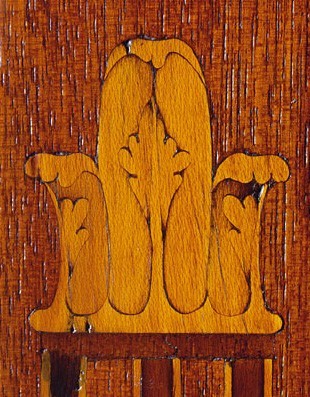
Detail of the right inlaid capital of the secretaire à abattant illustrated in fig. 4. (Photo, Gavin Ashworth.)

Detail of the inlay on the skirt on the secretaire à abattant illustrated in fig. 4. (Photo, Gavin Ashworth.)

Sideboard attributed to Bankson and Lawson, Baltimore, Maryland, 1785–1792. Mahogany and mahogany veneer with tulip poplar and yellow pine. H. 39 1/4", W. 58 7/8", D. 25 1/4". (Courtesy, Baltimore Museum of Art; purchased as the gift of Mr. and Mrs. Kenneth S. Battye.) The brasses are replaced.
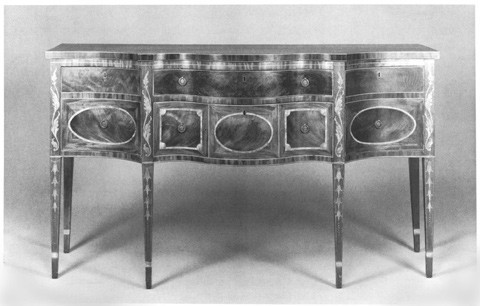
Sideboard attributed to Bankson and Lawson, Baltimore, Maryland, 1785–1792. Mahogany and mahogany veneer with tulip poplar and yellow pine. H. 40 1/4", W. 69 1/2", D. 26". (Private collection; photo, Sotheby’s.)
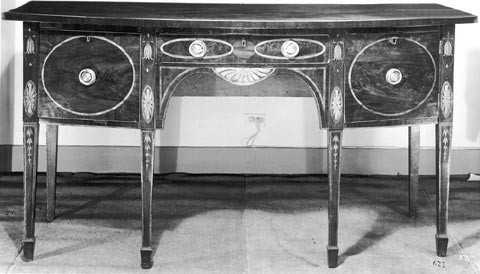
Sideboard attributed to Bankson and Lawson, Baltimore, Maryland, 1785–1792. Mahogany and mahogany veneer with tulip poplar and yellow pine. H. 37 1/2", W. 69 1/2", D. 27 1/2". (Courtesy, Sack Heritage Group.) www.sackheritagegroup.com
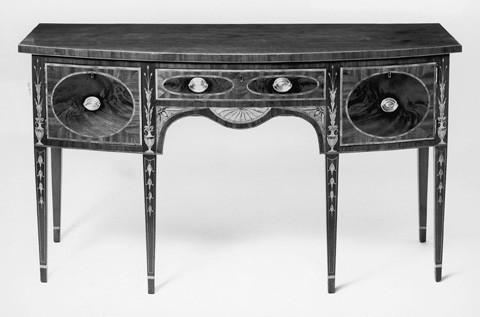
Sideboard attributed to Bankson and Lawson, Baltimore, Maryland, 1785–1792. Mahogany and mahogany veneer with tulip poplar and yellow pine. H. 40 1/2", W. 72 3/8", D. 27 7/8". (Courtesy, Diplomatic Reception Rooms, United States Department of State; gift of Mr. and Mrs. Mitchell Taradash.)

Tall clock case by William Patterson, Baltimore, Maryland, ca. 1797. Mahogany and mahogany veneer with tulip poplar and yellow pine. H. 90", W. 21 1/8", D. 9 1/2". (Private collection; photo, Gavin Ashworth.) The case has an eight-day movement by Baltimore clockmakers Mountjoy and Welsh (w. 1797).
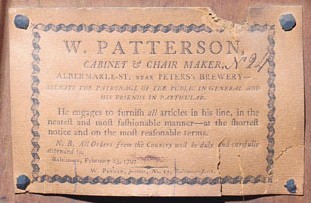
Detail of the label on the tall clock case illustrated in fig. 36. (Photo, Gavin Ashworth.)
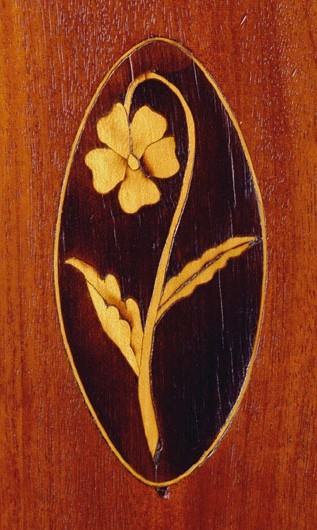
Detail of the inlay on the waist door of the tall clock case illustrated in fig. 36. (Photo, Gavin Ashworth.)

Detail of the shell on the plinth of the tall clock case illustrated in fig. 36. (Photo, Gavin Ashworth.)

Tall clock case with eight-day movement by William Thompson, Baltimore, Maryland, ca. 1794. Mahogany and mahogany veneer with tulip poplar and yellow pine. H. 98 1/4", W. 22 1/2", D. 11 1/2". (Private collection; photo, Jeff Goldman.) The tympanum, scroll moldings, and feet are replaced. The original feet were almost certainly ogee in form.

Tall clock case with eight-day movement by William Elvins, Baltimore, Maryland, 1795–1800. Mahogany and mahogany veneer with tulip poplar and yellow pine. H. 96 1/2", W. 19 1/2", D. 10 3/8". (Private collection; photo, Gavin Ashworth.)

Detail of the hood of the tall clock case illustrated in fig. 41. (Photo, Gavin Ashworth.)

Tall clock case, Baltimore, Maryland, 1795–1800. Mahogany and mahogany veneer with tulip poplar and yellow pine. H. 102 1/2", W. 20", D. 10". (Private collection; courtesy, Israel Sack, Inc.)
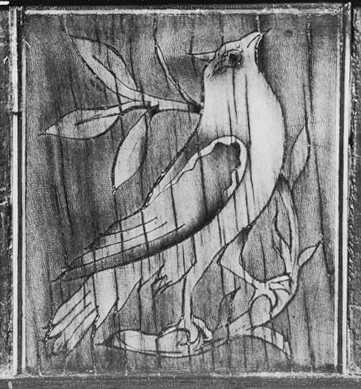
Detail of the oriole inlay on the pediment of the tall clock case illustrated in fig. 43.

Tall clock case, possibly Baltimore, Maryland, 1795–1805. Mahogany and mahogany veneer with tulip poplar and yellow pine. H. 104 1/2", W. 21 1/2", D. 10". (Private collection; photo, Gavin Ashworth.)
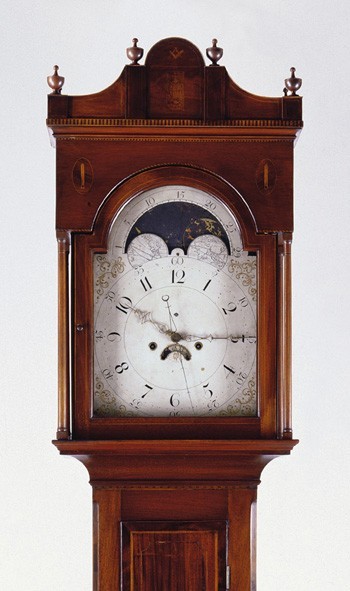
Detail of the hood of the tall clock case illustrated in fig. 45. (Private collection; photo, Gavin Ashworth.)
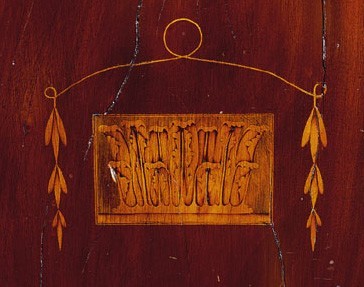
Detail of the inlay on the plinth of the tall clock case illustrated in fig. 45. (Private collection; photo, Gavin Ashworth.)
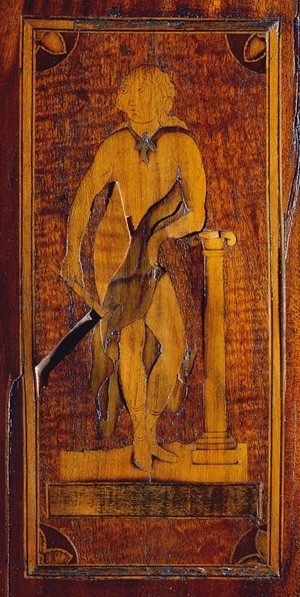
Detail of the inlay on waist door of the tall clock case illustrated in fig. 45. (Private collection; photo, Gavin Ashworth.)
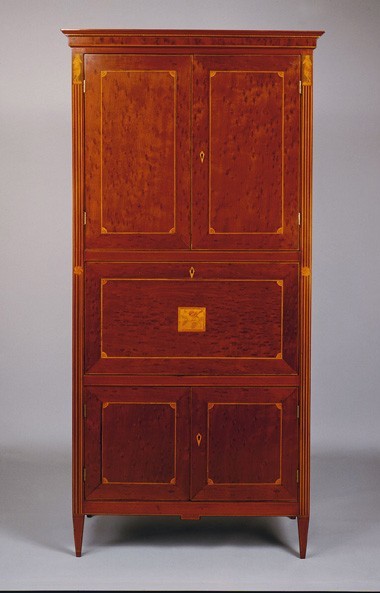
Secretaire à abattant attributed to Bankson and Lawson, Baltimore, Maryland, ca. 1792. Mahogany and mahogany veneer with tulip poplar. H. 82", W. 37", D. 17 1/4". (Private collection; photo, Jeff Goldman.)

Detail of the figural inlay on a front stile of the secretaire à abattant illustrated in fig. 49. The maker of this inlay was occasionally indifferent to anatomy. The feet of the utist are brought to a point like the toes of the bird and animal inlays shown in figs. 25, 27, and 44.

Card table (one of a pair), Baltimore, Maryland, 1795–1800. Mahogany and mahogany veneer with tulip poplar, yellow pine, and oak. Dimensions not recorded. (Private collection; photo, Gavin Ashworth.) The undersides of the tops are inscribed “P Lightfoot/ Port Royal.”
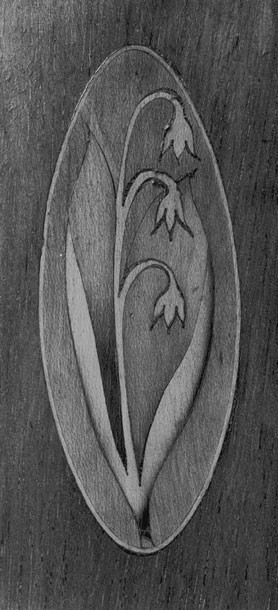
Detail of the lily inlay on the card table illustrated in fig. 50. (Photo, Gavin Ashworth.)
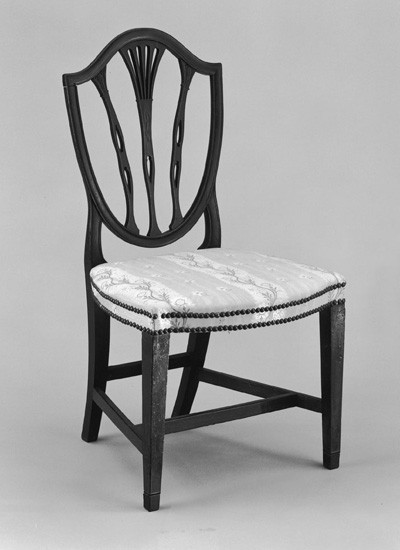
Side chair, Baltimore, Maryland, 1795–1800. Mahogany with maple and tulip poplar. H. 38", W. 19 7/8", D. 18 1/2". (Courtesy, Colonial Williamsburg Foundation.)
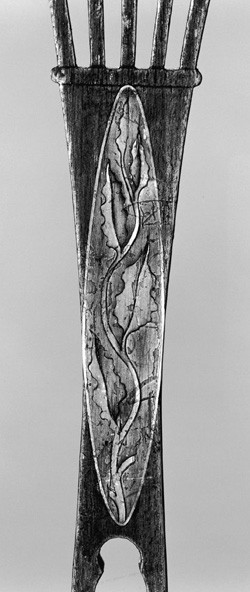
Detail of the vine inlay on the back of the side chair illustrated in fig. 53.

Detail of the vine inlay on the card table illustrated in fig. 51. (Photo, Gavin Ashworth.)
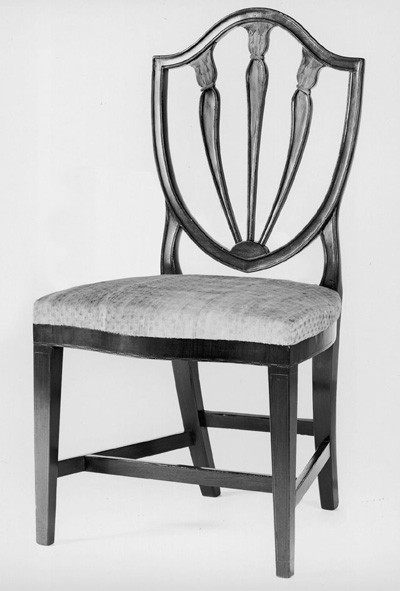
Side chair, Baltimore, Maryland, 1795–1805. Mahogany with tulip poplar. H. 37 3/4", W. 20 1/4", D. 17 1/2". (Courtesy, Winterthur Museum.)
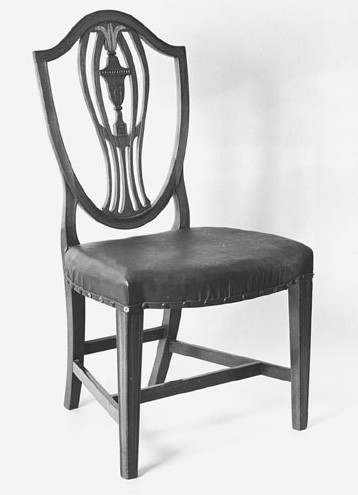
Side chair, Baltimore, Maryland, 1795–1805. H. 37 1/4". Mahogany; secondary woods not recorded. (Courtesy,Old Salem Inc; Museum of Early Southern Decorative Arts.)
English taste and workmanship have, of late years, been much sought for by surrounding nations . . . who seek a knowledge . . . in the various articles of household furniture.
—George Hepplewhite, The Cabinet-Maker and Upholsterer’s Guide (1788)
In the aftermath of the Revolution, America’s strong economy provided an opportunity for an unprecedented number of British artisans to escape the depression that had crept over the empire during the 1770s and 1780s. Ironically, these artisans helped to shape material culture in the new republic at precisely the point when Americans perceived themselves to be increasingly free of British influence.[1]
Of all the American cities, few benefited more strongly or more visibly from the influx of British artisans than did Baltimore—the most rapidly growing urban area during the last two decades of the eighteenth century. When John Moale made the original sketch for “Baltimore in 1752” (fig. 1) there were fewer than 30 houses and 250 inhabitants. By 1776 there were 564 houses and over 6,000 inhabitants. The population grew to 13,503 by 1790 and to 26,500 by 1800.[2]
Once a small trading center conveniently located at the juncture of the Patapsco River and the Chesapeake Bay, Baltimore became the leading port for the export of grain in America. Farmers in western Maryland, the Shenandoah Valley, and central Pennsylvania shipped vast quantities of flour and grain to Baltimore, where it was loaded onto ships bound for other American ports, Europe, and the West Indies. This hinterland also became an increasingly important market for the products of Baltimore tradesmen as well as for European goods imported by the city’s merchants. In 1770, British traveler William Eddis noted that the city was “the most wealthy and populous . . . in the province” and possessed a “well conducted and universal commercial connexion.” Trade with the piedmont region was so lucrative that it “became an object of universal attention,” attracting people of a “commercial and enterprising spirit . . . to this new and promising scene of industry.” In the same year, Virginia diarist Mary Ambler wrote that she had “not heard of a single inhabitant who [did] not carry on a trade or follow some Business.”[3]
Approximately thirty cabinetmakers worked as shop masters in Baltimore during the 1780s and early 1790s. At least 80 percent were born or trained in America and the vast majority came from Maryland. Only six cabinetmakers can be confirmed as adult British immigrants, of which three were English (Richard Lawson, Gualter Hornby, and William Singleton), two were Irish (John Dougherty and James McCormick), and one may have been Scottish (Thomas Aiton).[4]
Although small in number, these British artisans had a disproportionately large influence on Baltimore’s art and culture. The largest and most clearly identifiable group of Baltimore neoclassical furniture reflects the strong influence of English taste and the skills and imagination of an artisan, or group of artisans, trained in a British metropolitan center. With their progressive forms and ambitious pictorial and naturalistic inlays, the earliest pieces document the flowering of neoclassical taste in urban Maryland during the mid-1780s. During the 1790s, the styles and construction techniques introduced by immigrant artisans filtered into Baltimore’s furniture-making trades as their journeymen and apprentices established their own shops or went to work for other masters in the city.
Urban British Influences in Baltimore Neoclassical Furniture
The earliest furniture associated with these immigrant artisans appears to be the product of a single, previously unidentified shop. In the mid-Atlantic region, this shop was the first to engage in the large-scale production of British neoclassical forms such as serpentine sideboards and tambour and cylinder “writing tables” and desks. This shop also introduced sophisticated continental forms—albeit interpreted through the filter of British taste. These included blockfront and serpentine chests (figs. 2, 3) radically different from other American examples and French style secretaires à abattant (fig. 4)—the earliest neoclassical examples produced this side of the Atlantic.[5]
A serpentine chest (fig. 3), two writing tables with bookcases (figs. 5, 6), and several sideboards (figs. 7, 8) suggest that the artisans in this shop trained abroad and arrived in America fully versed in the latest “antique” taste. Related forms appear in George Hepplewhite’s Cabinet-Maker and Upholsterer’s Guide (1788) (figs. 9-11), the Society of Upholsterer’s Cabinet-Makers’ London Book of Prices (1788) (fig. 12), and Thomas Shearer’s Designs for Household Furniture (1788). The earliest pieces in the Baltimore group are stylistically rooted in the 1770s, however, and appear to predate these volumes. None of these publications illustrate designs that were new in the late 1780s; rather, they depict forms and decorative details that had been fashionable for over a decade. The accounts of British cabinetmakers working during the 1770s and early 1780s are replete with references to details used by this Baltimore shop.[6]
The advanced neoclassical style that emanated from this shop created a peculiar set of problems for the master to resolve. As the first in the region to use complex inlays, he had the option of importing them from abroad, purchasing them from a local inlay maker, or manufacturing them in his shop. A similar situation developed in Charleston, South Carolina, during the 1770s, but no other American parallels are known. In fact, the special circumstances that confronted these early masters were alleviated in the late 1780s by the growth of shops that specialized in the production of inlay medallions and ornamental banding that could be purchased in quantity and inserted in furniture when and where it was needed.[7]
Inlay making had been a specialty in Europe since the Renaissance, but it did not become widespread in America until the 1790s. The artisan who produced the inlays on the earliest furniture attributed to this Baltimore shop was an exception. Working for or in close cooperation with the shop master, he produced inlays that were sophisticated in concept and carefully integrated into the design of each form. These inlays encompass a wide variety of subject matter including ribbons, husks, naturalistic foliage, rustic landscapes, animals, and classical and allegorical figures.
The chest of drawers illustrated in figure 13 has one of the most creative inlay designs found on American neoclassical furniture. The demonic face on the skirt (fig. 14) was almost certainly inspired by an early engraving, and may well represent Cerberus, the mythical three-headed dog that guards the gates of hell. Similar grotesques appear in a variety of seventeenth-century publications, including Daniel Rabel’s Cartouches de Différentes Inventions (1632).
The techniques used by this inlay maker are very distinctive. His work is extremely graphic, but less complex than that of later inlay makers. The most ambitious figural medallions typically have less than twenty pieces, and the individual components are large and have relatively simple outlines (see figs. 14, 15). Their principal definition was accomplished with heated sand, which scorched the edges of selected pieces, and blue-green (copper) and red dyes.
Many of the inlays were made for specific locations on specific pieces. The leafy meanders on the drawer fronts of the chest illustrated in figure 3 are similar to those on the friezes of several bookcases in the group, but their scrolled ends were designed to wrap around and accentuate the neoclassical backplates (fig. 16). Even the most elaborate pictorial compositions appear to have been produced one at a time. Few of the subjects occur in multiples, and when they do, the images usually differ in size or detail.
Although the inlays on furniture in this Baltimore group are idiosyncratic, the construction of the earliest case pieces has parallels in contemporary London work. All of the desks, bookcases, and chests have dovetailed cases, and many of the bookcases have paneled backs. Drawer dividers are approximately three inches deep, and the dustboards behind them extend to the back of the case. Each dustboard is set into a groove on the back edge of the drawer divider and into dadoes in the sides of the case. To conserve materials and reduce the weight of the case, the cabinetmakers in this shop used thin dustboards with laminated strips that extend into the dadoes at each side (fig. 17). They oriented the grain of the strips parallel to that of the dustboards so they would shrink and expand sympathetically, which helped prevent the sides from cracking. Even the base of one chest (fig. 2) is constructed in a similar manner (fig. 18). Strips glued at either end provided extra thickness and strength around the dovetails and allowed the maker to use a thinner and lighter board for the bottom. None of these structural features is unique, but in combination and in an American context they are exclusive to this shop.[8]
Four basic foot designs appear on pieces in the group. The ogee (fig. 19) and French (figs. 13, 14) forms are typically supported from behind by a single vertical block with smaller horizontal flankers. Cabriole feet (fig. 4) are invariably cut from extensions of the front and rear stiles, just as they are on the Louis XV furniture that inspired them. The construction techniques for spade feet vary slightly according to the form of the case. On the serpentine chest illustrated in figure 3, the front feet are composed of two facings with a block behind. On the blockfront chest illustrated in figure 2, the front feet have three faces (fig. 18).
The finest serpentine and blockfront pieces (figs. 2, 3) have drawers veneered with vertically grained crotch mahogany. Drawer “fronts veneered with upright birchings” were an option offered by the Gillow firm of London and Lancaster in 1789. Another stylish alternative was the use of oval or lozenge-shaped veneer panels, a more expensive option than the horizontally figured veneers found on most of the chests and desks in the early Baltimore group. On many of these pieces, the drawers are decorated with satinwood or mahogany banding and edged with light-and-dark stringing.[9]
The earliest hardware on furniture in the Baltimore group consists of two types—bail and rosette brasses and ring pulls with a single post. The ring pulls typically have cast or stamped backplates emblazoned with urns, husks, or floral designs. Stamped oval brasses with two posts do not appear on any pieces attributed to this shop, but they are common on later Baltimore work. The earliest known illustration of such brasses is in the appendix of the third edition of Sheraton’s Cabinet-Maker and Upholsterer’s Drawing Book (1802).[10]
The design, construction, and ornament of the furniture in the early Baltimore group suggest that the shop master was a British-trained immigrant conversant with the latest cabinetmaking techniques and neoclassical styles. His production of technically demanding forms, such as cylinder-front desks, and careful integration of visually complex inlays indicate that he had worked in a large shop with a high degree of specialization. The only Baltimore cabinetmaker whose training and subsequent career fits all these criteria and dovetails with the dates assigned to the early Baltimore group is Richard Lawson (1749–1803).
Authorship: The Case for Bankson and Lawson
A strong case can be made for attributing all of the furniture in the early group to Lawson and his partner John Bankson (1754–1814). Lawson (fig. 20) was born at Keighley in Yorkshire, England, in 1749. He arrived in Baltimore by June 18, 1785, when he billed Richard Tilghman for a counting-house desk valued at £3.15, a bookcase valued at £12, and locks, hinges, and other hardware valued at £1.5. Two weeks later Lawson announced his partnership with Bankson:
The subscribers, having formed a connection in the [cabinetmaking] . . . business, inform their friends, and the public, that they have removed to their large and convenient ware-house, next door to Mr. M’Candless’s tavern and nearly opposite Messrs. Samuel and John Smith, merchants, in Gay-Street. As their joint stock in trade consists of a large and general assortment of mahogany, &c. they enabled to have on hand a variety of cabinet and chair work, of the most new and approved patterns, where their former customers in Town, on the Eastern Shore of Maryland, and elsewhere may be supplied at the shortest notice.
In a subsequent advertisement Lawson reported that he had “experience of 13 years, in Mr. Seddon’s cabinet warehouse, in London . . . [where] he . . . acquired such knowledge in the business, as to give general satisfaction.” His career provides one of the most significant connections to a prominent London cabinetmaker recorded in eighteenth-century America. No other Baltimore cabinetmaker boasted such credentials.[11]
Seddon and Sons was the largest furniture-making business in London in the last quarter of the eighteenth century. Founded by George Seddon (ca. 1727–1801) during the 1750s, the firm first appears in city directories in 1763. Newspaper accounts in 1768 reveal that the company employed eighty cabinetmakers and was “one of the most eminent . . . in London.” Seddon and Sons expanded their operation during the 1760s and 1770s, hiring both local and provincial joiners. A disastrous fire that swept through their establishment in 1783 may have prompted Lawson to immigrate. By the time Lawson left, the company employed nearly three hundred workers. When German traveler Sophie von La Roche visited the reconstructed shop in 1786, she observed joiners, carvers, gilders, painters, upholsterers, drapers, glass grinders, and bronze casters—a workforce capable of manufacturing virtually anything Seddon’s patrons demanded. This was the environment in which Lawson trained and worked.[12]
Seddon and Sons was one of the few British cabinetmaking firms that produced furniture for American patrons during the neoclassical period. Among the company’s clients were Philadelphia financier William Bingham and his wife, Ann Willing. During a trip to Europe after the Revolution, they commissioned plans for a neoclassical townhouse from London architect John Plaw. Subsequently built in Philadelphia, their home had carved reliefs on the façade, a formal garden furnished with classical statuary, and the earliest marble staircase recorded in America. When Englishman Henry Wansey visited in 1794, he wrote:
[The Binghams have a] magnificent house and gardens in the best English style, with elegant and even superb furniture: the chairs of the drawing room were from Seddon’s of London, of the newest taste; the back in the form of a lyre, adorned with festoons of crimson and yellow silk, the curtains of the room a festoon of the same.
Three years later, Baltimore merchant Hugh Thompson purchased a “Mahogany Writing Screen banded with sattin wood” and a “Sattin wood Oval Purse Table fine wood, rich Jappan’d center & highly varnished” from the firm, which had changed its name to Seddon Sons and Shackleton. These references document the demand for sophisticated neoclassical furniture similar to that produced by Bankson and Lawson.[13]
Bankson’s early career differed significantly from Lawson’s, but was equally important in the development of their business. The former was born on July 1, 1754, the son of Andrew and Sarah (Allen) Bankson of Philadelphia. If he was trained as a cabinetmaker, he probably completed his term by October 27, 1775, when he enlisted as an ensign in the Pennsylvania militia. Bankson was promoted to captain the following year and subsequently served as paymaster with various Pennsylvania regiments.[14]
Bankson’s military career suggests that he had little exposure to the neoclassical style before moving to Baltimore in 1784, and that Richard Lawson was primarily responsible for the design of the firm’s furniture. Evidence of the shop’s work in the new taste is found in a series of advertisements in newspapers from both Baltimore and Charleston, South Carolina. On July 29, 1785, the Maryland Journal and Baltimore Advertiser reported that Bankson and Lawson had “a variety of cabinet and chair work, of the most new and approved patterns,” and that “former customers in town, on the eastern shore of Maryland, and elsewere . . . [could] be supplied at the shortest notice.” The following May, Bowen and Markland, the printers of the Columbia Herald in Charleston, stated that they would transmit orders for furniture to Bankson and Lawson. Among the forms the cabinetmakers advertised were mahogany desks priced at thirty-eight to forty-five dollars, bureau or dressing tables priced at twenty-four dollars, and fashionable “wardrobe[s] . . . with large drawers and sliding doors within, and large drawers below.” Their use of the term “wardrobe” is significant, since it does not occur in British design books published before 1788. Bankson and Lawson’s venture must have met with some success, for just over a year later Bowen and Markland advertised furniture made by Bankson and Lawson for a “gentleman lately deceased.” Included were a wardrobe, sideboard, a set of “Northumberland” dining tables, a dozen vase-back chairs, and a pair of circular card tables—furniture unquestionably made in the neoclassical style.[15]
The frieze inlay on the desk-and-bookcase illustrated in figure 21 may have been inspired by one of the firm’s low-country exports. Although the composition of the meander (fig. 22) has parallels in work associated with Bankson and Lawson (see figs. 3, 7, 19), the design of the pediment, inlaid star, and cypress secondary woods suggest that the desk-and-bookcase is the product of a South Carolina shop (fig. 23). None of the Baltimore meanders are engraved like those on the desk-and-bookcase (fig. 24); however, similar shading occurs on Charleston furniture from the mid-1770s to the late 1790s.[16]
Bankson and Lawson’s advertisements also reveal that they operated a “Ware-house” and maintained stock-in-trade consisting of “a variety of elegant and useful furniture.” They specified eighteen different furniture forms, most of which were available in “ornamented and plain” versions. Although most American cabinetmakers maintained a small inventory, few had the capital, credit, or workforce to support a warehouse. The federal census of 1790 reveals that the firm employed eight males over sixteen years of age and one younger male, making it the largest shop in eighteenth-century Baltimore—one of sufficient size to employ specialized tradesmen. No other furniture warehouse was recorded in Baltimore at that date.[17]
Lawson’s background in one of the most accomplished circles of London’s cabinetmaking trade and Bankson’s strong regional connections all but guaranteed the success of their partnership. Within four years of establishing their business, they had attained an eminent position within Baltimore’s cabinetmaking community. In 1788, they led the cabinetmakers in a procession celebrating the ratification of the Constitution, displaying an “ensign” representing a cabinet and emblazoned with the motto “May our cabinet be enriched by a union of the states.”[18]
The firm’s prominence is also suggested by its clients, who included members of Baltimore’s wealthiest and most influential families. General Otho Holland Williams bought expensive settees from the partnership in 1789, and Charles Carnan Ridgely purchased at least £195 worth of unspecified furniture for his new country house, Hampton, in 1792. Located approximately twelve miles north of Baltimore, Hampton was built between 1783 and 1790 and was one of the largest houses in America. Throughout the 1790s, Ridgely furnished his home with expensive goods purchased from London, New York, and Baltimore.[19]
Like many of their contemporaries, Bankson and Lawson augmented their business by selling mahogany logs and planks and imported goods such as tea caddies, looking glasses, and upholstery fabrics. In the October 25, 1791, issue of the Maryland Journal and Baltimore Advertiser, they advertised “an assortment of hardware suitable for Cabinet-Makers.” This implies that they had direct access to London, Birmingham, and Liverpool suppliers or their British agents and a broad range of options for the brasses they used. Bankson and Lawson must have been enjoying a brisk business at the time, since they also advertised for “a few good journeymen cabinet and chair-makers.”[20]
On December 13, 1792, the Maryland Journal and Baltimore Advertiser reported that “the partnership of Bankson and Lawson will be dissolved on the 31st Instant, by mutual consent” and that Bankson proposed “to carry on the cabinet and chair manufactory in the same extensive line as heretofore.” Six weeks later, Bankson advertised that he had formed a partnership with Robert Wilkinson (fl. 1793–1799), a former apprentice of Baltimore cabinetmaker William Askew (fl. 1780–1786). Bankson evidently retained all the tools, materials, cabinetwork, and imported goods from his former partnership. The dissolution of Bankson and Lawson and the subsequent formation of new businesses by the principals and their workmen contributed significantly to the dissemination of London neoclassical style in the Baltimore school.[21]
Furniture Attributed to Bankson and Lawson
Richard Lawson’s London training and his partnership with John Bankson provide strong circumstantial evidence for attributing all of the pieces in the early Baltimore group to their shop. The sophisticated construction, distinctive inlays, and chronology of forms—some of which combine late rococo and nascent neoclassical details—represent the work of a large, multifaceted cabinetmaking enterprise that flourished from the mid-1780s to the early 1790s. No other British furniture makers who immigrated to Baltimore established shops of this size or complexity during the period, and no larger group of contemporaneous furniture is known.[22]
From a stylistic standpoint, the desk-and-bookcase illustrated in figure 19 is one of the earliest pieces in the Baltimore group. Its slanted fall front, ogee feet, “Chinese” mullions, and bail-and-rosette brasses reflect conservative rococo tastes that fell from favor in Baltimore soon after the Revolutionary War. The construction of the case, and the design and execution of the eagle inlay on the fallboard (fig. 25) and meander on the frieze, however, clearly link it with the most advanced neoclassical pieces (fig. 3) attributed to Bankson and Lawson. A smaller version of this eagle also appears on an inlaid oval on the prospect door of the writing compartment.[23]
The tambour writing tables and bookcases (figs. 5, 6) attributed to Bankson and Lawson are among the earliest American examples and may predate the firm’s cylinder-front forms. In 1788, Hepplewhite noted that writing tables were “very convenient . . . answering all the uses of a desk, with a much lighter appearance.” The legs on the example illustrated in the Cabinet-Maker and Upholsterer’s Guide are relatively plain, whereas those on the Baltimore writing tables are decorated with ovals and graduated pendant husks.[24]
Cylinder-front forms were particularly well suited for the display of elaborate pictorial inlays. The desk-and-bookcase shown in figure 26 has an oval panel inlaid with a stag and hound (fig. 27) derived from an allegorical illustration similar to those depicting Aesop’s fables. British carver Thomas Johnson used allegorical imagery in his publications for furniture and architectural details, and his apprentice Hercules Courtenay introduced many of his master’s designs when he immigrated to Philadelphia in 1765. The continued popularity of these designs in the mid-Atlantic region is demonstrated by an advertisement for Thomas Johnson’s One Hundred and Fifty New Designs (1758) in the November 18, 1783, issue of the Maryland Journal and Baltimore Advertiser.[25]
Three cylinder-front desks (fig. 28) attributed to Bankson and Lawson are known, the most elaborate of which have large eagle inlays and shaped skirts veneered with satinwood. Identical inlays appear on several pieces in the group, including the secretaire à abattant illustrated in figure 4 and the clothespress shown in figure 29. The cylinders and writing slides on furniture attributed to Bankson and Lawson are not connected and require the user to raise the former before pulling out the latter. Later cabinetmakers improved this design by constructing a cylinder that retracts when the slide is pulled out, a mechanism described in Thomas Sheraton’s Cabinet-Maker and Upholsterer’s Drawing Book (1793).[26]
A clothespress with a secretary drawer (fig. 29) is one of the most elaborate case pieces attributed to Bankson and Lawson. The pediment, prospect door, and skirt have exceptional pictorial inlays, and the upper doors have large ovals set in mitered fields similar to those on the cylinders of several desks and desk-and-bookcases (see figs. 26, 28). Like most Maryland clothespresses, this example has doors below the writing compartment and, presumably, linen drawers behind the doors. The grotesque inlay on the skirt is virtually identical to that on the early straight-front chest (figs. 13, 14).[27]
Secretaires à abattant are the most distinctive writing forms associated with Bankson and Lawson’s partnership. The earliest example (fig. 4) is tripartite in design, with a tambour upper section, writing compartment concealed by a large inlaid fall front, and three drawers below. As this piece suggests, French styles had a strong influence on British neoclassical design. The cabriole feet, flush-joined case sides, and vertical tambour have parallels in secretaires à abattant and armoires from France and areas of transplanted French culture. The tambour segments are relatively thick, ovoid in cross section, and decorated with the same multicolored, segmented block inlay found on the edges of the drawers, doors, and cases of several other pieces in the group. The stiles have inlaid pilasters with capitals composed of stylized leaves (fig. 30)—a detail that occurs on several related tall clock cases—similar to those on the skirt below (fig. 31).
The original owner of the secretaire à abattant (fig. 4) was Norfolk, Virginia, merchant Moses Myer. He may have purchased the piece shortly after the completion of his stylish neoclassical house in 1792, the final year of Bankson and Lawson’s partnership. Many merchants and planters in eastern Virginia owned Baltimore furniture after 1790.[28]
Sideboards with deep drawers and storage compartments were relatively new forms during the period when Lawson worked in Seddon’s shop and they appear to have been one of the mainstays of his and Bankson’s business. Commode examples (see figs 7, 8, 32, 33) were available in a variety of forms, the most architectural of which have arched spandrels and keystones below the center drawer. The husks on the sideboard illustrated in figure 7 and birds on the example shown in figure 8 appear on other pieces in the group (see figs. 15, 40), although few equal them in scale. With their geometric veneers and striking inlays, these sideboards undoubtedly occupied a prominent position in the households of their owners. George Hepplewhite noted that “the great utility of this piece of furniture has procured it a very general reception, and the conveniences it affords renders a dining room incomplete without a sideboard.”[29]
Some of the commode sideboards attributed to Bankson and Lawson have central cabinets or drawers rather than an arched skirt with spandrels. An example that reputedly descended in a family from Sandy Spring, Maryland (fig. 32), was clearly made for a niche, and its small size suggests that it may have been one of a pair. A larger, more elaborate sideboard (fig. 33) has leafy meanders on the upper leg stiles and satinwood banding on the lower cabinets and drawers. The husk pendants on the legs of these examples are miniature versions of those on the feet (fig. 15) of the straight-front chest (fig. 13) and spandrels of the sideboard shown in figure 7.[30]
Bowfront sideboards similar to those attributed to Bankson and Lawson became popular in England during the 1770s. In 1778, George Seddon invoiced one of his patrons for a “sweep front sideboard with . . . wine keeper in each end.” The bowfront sideboards in the early Baltimore group (figs. 34, 35) are similar in form. All have long central drawers surmounting an arched skirt and a deep door or drawer on either side. One has no inlays, but the others display a variety of decorative options including shells, fans, husks, and vase-and-flower inlay. The sideboard shown in figure 35 was undoubtedly more expensive than the one illustrated in figure 34. The former has stiles with elaborate vase-and-flower inlays and spandrels with three-petal leaf motifs.[31]
Continuing the Shop Tradition: Artisans Associated with Bankson and Lawson
In the absence of signed or labeled furniture by Bankson and Lawson, the most direct link between their shop and the early Baltimore group is a tall clock case (fig. 36) bearing the label (fig. 37) of their former apprentice William Patterson (1774–1816). By the time Patterson completed his term in 1795, he had incorporated the unusual combination of London structure and design and the idiosyncratic inlays characteristic of his masters’ shop.[32]
Patterson’s clock case has a broken-scroll pediment with a pierced tympanum and naturalistic inlays that are clearly derived from case pieces made a decade before he established his shop. The folded leaves on the waist door (fig. 38) have distinctive rounded lobes identical to those on numerous pieces in the group, including the drawers of the serpentine chest (figs. 3, 16) and friezes of several bookcases (figs. 5 , 21, 26). The finished edges of these leaves appear to have been cut with carving tools—the same type of gouges used to clean up the sawn outline of tympana piercings on this and other related tall clock cases. Similarly, the shell on the plinth of the Patterson clock (fig. 39) is one of several closely related variants found on earlier pieces, including the fallboard of a desk and skirt of the serpentine chest (fig. 3).[33]
On November 20, 1800, Patterson purchased 238 “shells” from the estate of Thomas Barrett, the earliest professional “ebonist” documented in Baltimore. Two days later, the Baltimore American reported that Patterson had begun the “Manufacturing of Stringing, Banding and Shells of every description at No. 24 Albemarle Street, Old Town.” The timing of Patterson’s advertisement suggests that he was attempting to attract Barrett’s clientele. The former remained in business until 1817.[34]
Barrett is first recorded as an independent artisan on February 18, 1795, barely six weeks after Bankson and Wilkinson dissolved their partnership. The fact that Patterson acquired inlays from Barrett’s estate that were compatible with those on earlier pieces attributed to his master, suggest that Barrett may have worked for Bankson and Lawson, Bankson and Wilkinson, or both.[35]
In Baltimore, the trade of an ebonist involved two allied skills—inlay making and cabinetmaking. This duality is implied in John Lennox’s apprenticeship agreement with Barrett, wherein the latter agreed to provide instruction in the “cabinetmaking” and “inlaying” trades. This indenture also suggests that Barrett was well established, and that he had previously worked in a shop where those trades had coexisted.[36]
Cabinetmaker William Singleton (1757–1803) may also have been associated with Bankson and Lawson. Described as a “native of England,” he first appears in Baltimore records in a petition supporting local manufactures submitted to the United States House of Representatives in March 1789. On May 18, 1790, Singleton reported that he and William McFadon had formed a partnership in the cabinetmaking business and that one of the principals had “experience in Europe” and “different parts of this continent.” The partners also boasted that “their Manufactures will be found equal to any imported, or made on the Continent.” Newspaper advertisements suggest that McFadon was in the lumber business with Richard Lawson at this time. Singleton may also have worked with Lawson when he first moved to town. If so, that would explain how he came to know his future partner McFadon.[37]
Singleton’s later connections to Lawson are easily verified. The former’s father-in-law, William Slater, was an immigrant hardware merchant whose second wife, Hannah (James), was Lawson’s sister-in-law. Both men were actively involved in St. Paul’s Church and had businesses that were, at the very least, indirectly connected. Goods for Slater’s hardware store occasionally arrived on Lawson’s ship, the Diana.[38]
By July 30, 1793, Singleton and McFadon had moved their shop to Water Street, in the heart of the business district. Their partnership ended three years later, and Singleton moved back to 11 North Gay Street. By this time, he must have been a prominent member of Baltimore’s cabinetmaking trade. Merchant Hugh Thompson purchased over £230 worth of mahogany furniture from him in the late 1790s.[39]
Furniture Attributed to the Bankson and Lawson School
A large group of Baltimore furniture made between 1795 and 1805 shares details with work attributed to Bankson and Lawson. Variations in the construction and design of the objects in this later group suggest that the pieces represent the work of several different tradesmen, which should come as no surprise given the size and complexity of Bankson and Lawson’s shop. Although cataloging all of these objects is outside the scope of this article, a survey of several different forms suggests the influence that the partnership had on Baltimore neoclassical furniture.
Many Baltimore tall clock cases have inlays similar to those used by Bankson and Lawson; however, most have movements that postdate the partnership and cases that probably represent the work of journeymen. Among the earliest examples are a case with a movement by William Thompson (w. 1796–1822) (fig. 40), a case with a movement by William Elvins (w. 1795–1816) (figs. 41, 42), and a case with an unsigned movement (fig. 43). The Thompson and Elvins clocks have ogee feet, square plinths, minimal stringing, and inlays that are both technically and stylistically related to those on furniture attributed to Bankson and Lawson. The Thompson clock also has inlaid birds that are virtually identical to those on the sideboard illustrated in figure 8, and the Elvins clock has spandrel inlays that are comprised of large segments (fig. 42) assembled in the same manner as many of the husks and floral designs in the early group. The tall clock case with the unsigned movement (fig. 43) is one of the most ornate Baltimore examples from the last decade of the eighteenth century. Its advanced neoclassical style—evident in the satinwood fields and crossbanding of the door and plinth and lavish inlay—places it squarely in the Bankson and Lawson shop tradition. Similarly, the oriole on the pediment (fig. 44) displays the same workmanlike techniques and creative design found on pictorial inlays in the early group.[40]
The inlays on a slightly later tall clock case (fig. 45) indicate that it belonged to a mason. Emblems of the craft include the compass, square, and plumb rules on the pediment (fig. 46), and Corinthian capital on the plinth (fig. 47). The most conspicuous symbol, however, is the figure on the waist door, which may depict the new republic’s most renowned leader and mason, George Washington (1732–1799), with his left elbow resting on a column and his right hand holding a square (fig. 48). Figural inlays by the same maker appear on pieces attributed to Bankson and Lawson’s shop.[41]
A secretaire à abattant (fig. 49) from the early 1790s helps bridge the gap between their firm’s work and that of their journeymen and apprentices. Like the Moses Myers example, this secretaire à abattant has a framed case, tripartite facade, and simple board top. Although most of the distinctive structural details and continental designs introduced by Bankson and Lawson were subsequently abandoned by the artisans who had worked for them, inlays associated with their shop appear on later pieces made in Baltimore and its hinterland. The classical flutists capping the pilasters (fig. 50), for example, appear to be by the same inlay maker responsible for the figure on the preceding clock case (fig. 48).
No tables or chairs can be definitively attributed to Bankson and Lawson, but a pair of card tables (fig. 51) that originally belonged to Philip Lightfoot of Port Royal, Virginia, are clearly part of their shop tradition. The lily inlays at the top of each front leg (fig. 52) have outlines that are remarkably similar to those of the feet on the eagle and oriole inlays shown in figures 25 and 44 and the classical flutists (fig. 50) on the secretaire á abattant. Like the serpentine and blockfront chests attributed to Bankson and Lawson, the Lightfoot tables are exceptionally bold forms. Possible sources for the shape of their frames and tops are a pier table illustrated on plate 64 of Hepplewhite’s Cabinet-Maker and Upholsterer’s Guide and a card table illustrated on plate 11 in the appendix of Sheraton’s Cabinet-Maker and Upholsterer’s Drawing Book.[42]
The side chairs illustrated in figures 53, 56, and 57 may also be part of the Bankson and Lawson shop tradition. An example reputedly found on the eastern shore of Maryland has vine inlay and ebonized cuffs (figs. 53,54) related to those on the Lightfoot card tables (figs. 51, 55). Another shield-back chair of a different pattern (fig. 56) has vertical slats with leaf inlays whose edge profiles and central spine appear to have been derived from earlier work associated with Bankson and Lawson’s shop.[43]
The vase-back side chair illustrated in figure 57 also has related inlay. Although its back design is unconventional, it has parallels in published engravings, including plate 4 of Hepplewhite’s Cabinet-Maker and Upholsterer’s Guide. Bankson and Lawson made vase-back chairs as early as 1788, when the printers of the Columbia Herald advertised “one dozen Vanzebank chairs with two Elbow ditto to suit” made by the firm for a “gentleman lately deceased.”[44]
These later objects only begin to suggest the influence that Bankson and Lawson had on Baltimore furniture in the neoclassical style. Although their partnership lasted only seven years, they assembled a large workforce capable of producing London-style furniture as well as pieces that accommodated more conservative Baltimore tastes. With the dissolution of their partnership and subsequent establishment of new businesses by their journeymen and apprentices, their shop tradition extended into the early years of the nineteenth century. Much of the stylistic vocabulary they introduced has become synonymous with Baltimore’s neoclassical school.
ACKNOWLEDGMENTS
For assistance with this article, the authors thank Gavin Ashworth, Wendy Battaglino, Frank Horton, Deanne Levison, Martha Rowe, Jane Webb Smith, and all of the institutions and individuals who allowed them to inspect and illustrate their furniture. Special thanks are due to Ronald L. Hurst for his substantial intellectual contributions and Ann Rodgers Haley, Joan Quinn, Page Talbott, and Michael Hall for their genealogical research.
George Hepplewhite, The Cabinet-Maker and Upholsterer’s Guide (1788), preface.
Wilbur H. Hunter, “Baltimore in the Revolutionary Generation,” in Maryland Heritage: Five Baltimore Institutions Celebrate the American Bicentennial, edited by John B. Boles (Baltimore: Maryland Historical Society, 1976), p. 189.
From a letter by William Eddis in Letters from America, edited by Aubrey C. Land (Cambridge, Mass.: Belknap Press, 1969), p. 13. Gary B. Nash, The Urban Crucible: Social Change, Political Consciousness, and the Origins of the American Revolution (Cambridge: Harvard University Press, 1979), p. 408.
Richard Lawson’s birthplace is recorded on the painting illustrated in fig. 20. Gualter Hornby’s name appears in the Baltimore County Naturalization Docket (Robert Barnes, Baltimore Naturalizations, 1796–1803, a supplement to the Baltimore Town and Fell’s Point Directory of 1796 [1796; reprint ed., Silver Spring, Md.: Family Line Publications, 1983], p. 61). William Singleton is described as a “native of England” in the records of St. Paul’s Parish (Bill and Martha Reamy, Records of St. Paul’s Parish, 2 vols. [Westminster, Md.: Family Line Publications, 1989], 2:23). John Dougherty and James McCormick were described as being from Great Britain in the Baltimore County Naturalization Docket (Barnes, Baltimore Naturalizations, p. 59). For more on McCormick, who was born in County Tyrone, Ireland, see Dr. J. Hall Pleasants Files in Early American Portraiture, file no. 513, Gallery Office, Maryland Historical Society, Baltimore (hereafter cited MHS). In the February 21, 1786, issue of the Maryland Journal and Baltimore Advertiser, McCormick reported that he had “for some years past worked in the first shops in Dublin. Aiton reported that he was “from Europe” in an advertisement in the April 22, 1783, Maryland Journal and Baltimore Advertiser.
For more on the production of secretaires à abattant, see Peter M. Kenny, Francis Bretter, and Ulrich Leben, Honoré Lannuier: Cabinetmaker from Paris (New York: Harry Abrams for the Metropolitan Museum of Art, 1998), pp. 16–18, 71, 79; and Charles L. Venable, “Germanic Craftsmen and Furniture Design in Philadelphia, 1820–1850,” in American Furniture, edited by Luke Beckerdite (Hanover, N.H.: University Press of New England for the Chipstone Foundation, 1998), passim. The earliest secretaires à abattant in the Baltimore group (see fig. 4) appear to predate those associated with Lannuier by more than a decade.
The terms “antique” and “palmyrian” were often used to describe the neoclassical taste. For more on these design sources, see Elizabeth White, comp., Pictorial Dictionary of British Eighteenth-Century Furniture Design: The Printed Sources (Woodbridge, Suffolk, England: Antique Collector’s Club, 1990), passim.
J. Thomas Savage, “The Holmes-Edwards Library Bookcase and the Origins of the German School in Pre-Revolutionary Charleston,” in American Furniture, edited by Luke Beckerdite (Hanover, N.H.: University Press of New England for the Chipstone Foundation, 1997), pp. 106–27; John Bivins, “The Convergence and Divergence of Three Stylistic Traditions in Charleston Neoclassical Case Furniture, 1785–1800,” in ibid., pp. 47–106; research files of the Museum of Early Southern Decorative Arts (hereafter cited MESDA), Winston-Salem, North Carolina.
The backs of standard chests typically have vertically grained boards with tongue-and-groove joints. Many of these construction practices evolved in London during the 1730s and continued in use for high-end British furniture throughout the eighteenth century.
Lindsay Boynton, ed., Gillow Furniture Designs (Royston, England: Bloomfield Press, 1995), p. 168, entry for March 11, 1789. Cock-beading is rarely found in the early Baltimore group. The bottoms of large drawers are set in a groove in the front, dadoed to the sides, nailed at the back, and reinforced along the sides and front with tightly clustered glue blocks. In contrast, the bottoms of the small drawers are glued into rabbets in the front and sides. The rear edges of all the drawers are secured with wrought sprigs. Some furniture scholars consider this structure less sophisticated than the rabbeted drawer construction typical of mid-eighteenth-century London casework; however, many cabinetmakers abandoned such early construction practices during the last quarter of the century in favor of the simpler work found here, particularly for large case drawers. The bottom boards of all large drawers in the early Baltimore group run side to side. Most are nailed up into the drawer backs with four or five wrought finish nails, although forged T- and L-shaped heads occur sporadically. The bottom boards on interior drawers run front to back. The boards are rabbeted to the sides and front and secured with tiny wrought finish nails at the rear. The dovetails of the large and small drawers have tight, narrow pins and precisely sawn tails. No kerfs are visible on the interior surfaces, indicating that the cabinetmakers finished their work with chisels like many of their British contemporaries. The large drawer fronts typically have mahogany cores and mahogany veneer. On some examples (see figs. 2, 3) the cores are laminated.
Marston and Bellamy of Birminghan patented the process for die-stamping brasses in 1779 (Ralph Edwards, The Shorter Dictionary of English Furniture [London: Country Life, 1954], p. 306).
The earliest information on Lawson comes from the inscription on his portrait by Maryland artist Charles Peale Polk (fig. 20). Polk charged Lawson £17.10 for this portrait and another of Lawson’s wife (Charles Peale Polk to Richard Lawson, November 27, 1794, Library Manuscripts Collection, MHS). Richard Lawson’s father, Stephen, was a carpenter who married Agnes Simpson in 1743. Richard was baptized in 1750. His father subsequently worked as a baker in Keighley. Tench Tilghman Papers, ms. 1445, MHS. Maryland Journal and Baltimore Advertiser, July 29, 1785. Although dated July 1, this advertisement did not run until four weeks later. Several Baltimore cabinetmakers had shops on Gay Street. Bankson and Lawson’s shop was on the east side in the first block south of Market, the city’s main commercial thoroughfare. In 1786, the firm moved approximately three blocks west, to the southwest corner of Light Lane and Bank Street, a location closer to the city’s wharves.
For more on the Seddon firm, see Sir Ambrose Heal, The London Furniture Makers from the Restoration to the Victorian Era, 1660–1840’s (1933; reprint ed., New York: Dover, 1972), pp. 161–62; and Geoffrey Beard and Christopher Gilbert, eds., Dictionary of English Furniture Makers, 1660–1840 (Leeds, England: W. S. Maney and Son for the Furniture History Society, 1986), pp. 793–99. Like many of his contemporaries, George Seddon produced architectural woodwork in addition to furniture. Between 1781 and 1789, his firm furnished interior components for the Greenwich Hospital Chapel, where he assisted cabinetmaker James Arrow (Geoffrey Beard, Craftsmen and Interior Decoration in England, 1660–1820 [New York: Holmes and Meier, 1981], p. 242). No record identifying Seddon’s early apprentices is known, nor are there daybooks or objects surviving from the period when Lawson reputedly worked for the firm. George Seddon II (1765–1815) and his brother Thomas (1761–1804) joined the firm in 1785 and subsequently took Thomas’s brother-in-law Thomas Shackleton as a partner. During the 1790s, the firm received the first of many documented royal commissions and became the largest cabinet shop in London. By 1827, when the elder George Seddon’s grandson and namesake took Nicholas Morel as a partner, most of the company’s clients were members of the royal family. Sophie von La Roche’s visit is described in ibid.
Henry Wansey, Journal of an Excursion to the United States of North America in the Summer of 1794, 2d ed., as quoted in David Barquist, “‘The Honours of a Court’ or ‘the Severity of Virtue,’” in Shaping a National Culture: The Philadelphia Experience, 1750–1800, edited by Catherine Hutchins (Winterthur, Del.: Winterthur Museum, 1994), p. 324. The author thanks Ron Fuchs for this reference. Invoice from William Murdoch to Hugh Thompson for “sundries shipped from Seddon Sons & Shackleton,” May 2, 1797, ms. 990, MHS.
John D. Kilbourne, Vitruvius Praemium: The Men Who Founded the State Society of the Cincinnati of Pennsylvania (Rockport, Maine: Picton Press, n.d.), pp. 6, 255, 1100. From May 1784 to June 12, 1785, Bankson was in partnership with Baltimore cabinetmaker William Gordon (d. 1798) (Maryland Journal and Baltimore Advertiser, May 18, 1784, and June 10, 1785).
Maryland Journal and Baltimore Advertiser, May 18, 1784. The Oxford English Dictionary cites the third edition of Hepplewhite’s Cabinet-Maker and Upholsterer’s Guide (1794) as having the first use of the term “wardrobe”; however, it also appears in the first edition (1788). Columbia Herald (Charleston), May 1, 1786, and June 14, 1787.
Columbia Herald (Charleston), May 1, 1786. Savage, “The Holmes-Edwards Library Bookcase,” pp. 106–27.
Maryland Journal and Baltimore Advertiser, June 17, 1788.
The procession is described in the Gazette of the State of Georgia (Savannah), June 12, 1788.
Gregory R. Weidman, “Baltimore Federal Furniture: In the English Tradition,” in The American Craftsman and the European Tradition, edited by Francis J. Puig and Michael Conforti (Minneapolis, Minn.: Minneapolis Institute of Arts, 1989), p. 258. Charles Carnan Ridgley, Ledger L, January 19, 1792, folio 62, G. Howard White Collection, Maryland State Archives, Annapolis.
Maryland Journal and Baltimore Advertiser, October 25, 1791; April 17, 1792, and February 11, 1793. Bankson took Englehart Reams as an apprentice in the cabinetmaking trade on October 10, 1792 (Baltimore County Orphans Court Proceedings, No. 3, 1792–1798, p. 13).
Baltimore Daily Repository, February 11, 1793. For more on Askew’s brief career, see Gergory R. Weidman, Furniture in Maryland, 1740–1940: The Collection of the Maryland Historical Society (Baltimore: By the society, 1984), p. 73. Baltimore Daily Repository, February 11, 1793, and August 23, 1793. Bankson and Wilkinson’s partnership lasted through 1795. Robert Wilkinson (1769–1853) was in business with William Smith at 16 Light Street by the time the first Baltimore city directory was published in 1796 (Baltimore Town and Fell’s Point Directory of 1796). On December 5, 1796, the Federal Gazette and Baltimore Advertiser reported that “a fire broke out in a frame building on the West side of Light Street. . . . The flames immediately caught Messrs. Wilkinson and Smith’s cabinet manufactory.” Two days later, Wilkinson and Smith thanked the public “for their particular attention and exertions at the late fire” and reported that they would “soon . . . establish and carry on their business as heretofore” (Federal Gazette and Baltimore Advertiser, December 7, 1796). Six months later, they dissolved their partnership (Federal Gazette and Baltimore Advertiser, June 6, 1797). Wilkinson continued in business on his own through 1799 (Baltimore Directory for 1799). The following year, the cabinet and chair manufactory of Combs and Jenkins moved from Water Street into the building formerly occupied by Wilkinson, Bankson and Wilkinson, and Bankson and Lawson (Federal Gazette and Baltimore Daily Advertiser, April 1, 1800). This marked the end of a business carried on by a succession of accomplished artisans for nearly two decades. By 1801, Bankson had established a lumber and import business on McElderry’s Wharf. This business prospered until Bankson’s death on June 5, 1814 (Baltimore Directory for 1801). Lawson had established a separate business as a lumber merchant at Bowly’s Wharf in 1789 (Maryland Gazette and Baltimore Advertiser, September 25, 1789). In January 1792, he sold his company to John McFadon (Maryland Gazette and Baltimore Advertiser, January 31, 1792). Lawson evidently retained an interest in the new firm. On November 8, 1802, the Telegraph and Daily Advertiser (Baltimore) reported that William and John McFadon and Richard Lawson had dissolved their “copartnership.”
Straight-front chests are among the most common furniture forms associated with the Bankson and Lawson shop tradition. See Baltimore Furniture: The Work of Baltimore and Annapolis Cabinetmakers from 1760 to 1810 (Baltimore, Md.: Baltimore Museum of Art, 1947), p. 135; and Charles Montgomery, American Furniture: The Federal Period in the Henry Francis du Pont Winterthur Museum (New York: Viking Press, 1966), pp. 184–85, no. 141.
“Chinese” mullions are illustrated in the first edition of Thomas Chippendale’s Gentleman and Cabinet-Maker’s Director (1754). All of the bookcases attributed to Bankson and Lawson that have been examined by the authors are secured to their lower cases with separately attached dovetailed battens. The cornices typically have dovetailed frames, and most have friezes veneered with cross-banded mahogany and vine inlay. The pediment frames have a series of large blocks glued to the interior and are attached to the top of the upper case with screws. The upper case usually has two rectangular blocks glued to its top, which help align the cornice and hold it in place. Although the cornice moldings differ from piece to piece, most have mahogany cove elements with triangular pine or tulip laminates. Several of the most expensive examples have cornice moldings pierced with gothic arches and decorated with acorn-shaped drops, each of which is applied separately (see figs. 6, 19). The doors on bookcases typically have intricate mullions accentuated with string inlay (see figs. 5, 6, 19). The mullions are invariably tenoned into the stiles and rails rather than being set in slots that are exposed on the interior of door. Most American cabinetmakers used the latter technique, which was quicker and cheaper. The construction of the door frames is also exceptionally neat and sturdy. The rails are through-tenoned, and the joints are secured with glue and wedges rather than with pins.
Hepplewhite, Cabinet-Maker and Upholsterer’s Guide, pl. 69.
A ca. 1768 carved chimneypiece from the Stamper-Blackwell house in Philadelphia (now in the Winterthur Museum) depicts a stag and hound in a pose similar to that inlaid on the cylinder of this desk-and-bookcase. A related stag-and-hound inlay is on the top of a tea table in a private collection. For more on the Stamper-Blackwell chimneypiece and the influence of Hercules Courtenay and carver John Pollard, see Leroy Graves and Luke Beckerdite’s article in this volume. Morrison H. Heckscher, “English Furniture Pattern Books in Eighteenth-Century America,” in American Furniture, edited by Luke Beckerdite (Hanover, N.H.: University Press of New England for the Chipstone Foundation, 1994), p. 191.
A desk virtually identical to the one shown in fig. 27 is illustrated on p. 103, fig. 76, in William Voss Elder III and Jayne E. Stokes, American Furniture, 1680–1880: From the Collection of the Baltimore Museum of Art (Baltimore, Md.: By the museum, 1987). A similar desk is owned by the University of Virginia and displayed in Pavillion VI. A secretary-and-bookcase illustrated in Weidman, Furniture in Maryland, pp. 135–36, no. 96, appears to be by Bankson and Lawson or one of their journeymen. Its scalloped, satinwood-veneered skirt is similar to those on the cylinder desks noted above, and its door mullions are derived from a design shown on pl. 27 in the Society of Upholsterer’s Cabinet-Makers’ London Book of Prices (1788). Another secretary-and-bookcase with a pierced tympanum, “Chinese” mullions, and French feet with inlaid husks similar to those shown in fig. 15 is illustrated in Sotheby’s, Important Americana, New York, January 26, 1989, lot 1496.
The authors have not inspected the clothespress and cannot verify its structure or the originality of the inlay on the prospect door and document drawers.
The secretaire à abattant descended in the Myer family until the Chrysler Museum acquired the house and its contents.
Hepplewhite, Cabinet-Maker and Upholsterer’s Guide (1788), text for pl. 29. The tops of the sideboards attributed to Bankson and Lawson’s shop (see figs. 7, 8, 32–35) are composed of thin mahogany boards with parallel laminates beneath the front, sides, and back. The tops of the serpentine and blockfront chests (figs. 2, 3) are constructed in a similar fashion. Most straight-front chests (see fig. 13) have dovetailed tops covered with veneer. Mitered strips nailed to the sides and front create the overhanging edges. These strips are generally veneered with cross-banded mahogany and inlaid with boxwood stringing, although more elaborate pieces have cross-banded satinwood. This applied overhang—which mirrors the earlier, rococo practice of applying a classical molding around the top edges of a dovetailed case—was abandoned in most American cities during the neoclassical period, but remained an integral part of Baltimore’s cabinetmaking tradition well into the nineteenth century.
For additional commode sideboards attributed to Bankson and Lawson, see advertisement for Joe Kindig, Jr., Antiques 50, no. 2 (August 1946): inside front cover; and Israel Sack, Inc., Antiques from Israel Sack Collection, 10 vols. (Alexandria, Va.: Highland House, 1981), 1:283.
Robert C. Smith, “A Bill From George Seddon,” Antiques (October 1960): 362–63. For the other bow-front sideboards attributed to Bankson and Lawson, see advertisement for Joe Kindig, Jr., Antiques 58, no. 1 (July 1950): inside front cover; Sotheby’s, The Garbisch Collection, vol. 4, New York, May 23, 1980, lot 1139; Elder and Stokes, American Furniture, pp. 148–49, no. 113; and private collection.
Indenture between Bankson and Lawson and William Patterson, April 2, 1789, Baltimore County Orphan’s Court Proceedings, no. 2, 1789–1792. Most apprenticeships lasted six to seven years. Although Lawson left the firm in 1792, Bankson and Wilkinson remained in business until 1796, the year Patterson first appears in Baltimore directories. Patterson married Nancy Craig at St. Paul’s Episcopal Church in July 1795 (Reamy, Records of St. Paul’s Parish, 1:89).
MESDA research file 10959.
Account of the Sale of Thomas Barrett, November 20, 1800, Baltimore County Inventories, vol. 2, folio, 688, Maryland State Archives, Annapolis. In 1803, Patterson moved to 22 Albemarle Street, where he remained until 1817.
Indenture between Thomas Barrett and John Lennox, February 18, 1795, Baltimore County, Maryland Orphans Court Proceedings, No. 3, 1792–1798, p. 136. Barrett married Elizabeth (maiden name unknown) prior to December 1788, when their son Thomas was born. The elder Barrett may not have been in Baltimore at the time of his and Elizabeth’s marriage, since no local license or church record is known. Four Thomas Barretts emigrated from England to America between 1765 and 1770, but no connection between these individuals and the Baltimore ebonist has been established. Two individuals whose last name was Barrett lived in Baltimore County during the 1760s, and a John Barrett resided in Baltimore during the 1780s and 1790s (Henry C. Peden, Jr., Inhabitants of Baltimore County, 1763–1774 [Westminster, Md.: Family Line Publications, 1989], p. 17). The latter was a communicant of St. Paul’s Church (Reamy, Records of St. Paul’s Parish, 1:50, 120).
Indenture between Thomas Barrett and John Lennox.
Reamy, Records of St. Paul’s Parish, 2:23. Singleton married Elizabeth Slater in St. Paul’s Church on March 20, 1793 (ibid., 1:69). U. S. Congress, “Manufactures: Communicated to the House of Representatives, April 11, 1789,” in American State Papers, vol. 1 (Boston: T. B. Wart, 1817), pp. 5–8. Maryland Journal and Baltimore Advertiser, May 18, 1790. Singleton and McFadon advertised at 11 North Gay Street in the January 29, 1796, Maryland Journal and Baltimore Advertiser. For additional listings at that address, see the Baltimore Town and Fell’s Point Directory of 1796 and the Baltimore Directory for 1799 (Baltimore, Md.: John Mullen, 1799). For more on McFadon’s association with Richard Lawson, see n. 23. The 1790 census (taken after March) does not list William Singleton in Baltimore. He may have been one of the three males over sixteen listed with William McFadon (First Census of the United States, 1790, Maryland [Baltimore, Md.: Southern Book Co., 1952], p. 17). Weidman, “Baltimore Federal Furniture,” p. 258, incorrectly states that McFadon was born abroad.
Lida Leiseuring, Maryland Marriage Records, 1777–1799 (Baltimore, Md., 1900), n.p. Reamy, Records of St. Paul’s Parish, 1:57, 99, 128, 159–60; 2:20. From 1796 to 1797, Singleton served as church warden and Richard Lawson was a vestryman. For a reference to the Diana, see the Baltimore American, July 14, 1804.
“Account of Mr. Thompson’s Furniture as taken from the original bills,” undated ms. (ca. 1800), Hugh Thompson Papers, ms. 990, MHS. In addition to this furniture, Thompson furnished his townhouse with lavish goods from London and Paris. Maryland Journal and Baltimore Advertiser, October 1, 1793. Singleton continued to purchase lumber from John McFadon and Co. in the late 1790s (John Hill, “The Furniture Craftsmen in Baltimore, 1783–1823” [M.A. thesis, University of Delaware, 1967], p. 131). The 1800 census lists three young men (ages 17–26) in addition to Singleton at his house/shop (G. Ronald Teeples, Maryland 1800 Census [Provo, Utah: Accelerated Indexing Systems, 1973], p. 493). In the October 1, 1793, issue of the Maryland Journal and Baltimore Advertiser he stated that “constant employ and liberal wages will be given to two or three good journeymen.” Singleton was also a client of Thomas Barrett and owed his estate $29.80 (Account of the Sale of Thomas Barrett).
English-born cabinetmaker Gualter Hornby (b. 1755–1760, d. 1816) was also in Baltimore during the period of Bankson and Lawson’s partnership; however, no documentation concerning his training, shop practices, or patrons is known. He, his wife Elizabeth (d. 1826), and at least one son, Walter, Jr. (d. 1793), arrived in the city by April 1783, when Gualter is listed as a “pauper” in the tax assessment list for East Baltimore Hundred in April of that year (Maryland Tax List, 1783: Baltimore County [Philadelphia, Pa.: Historic Publications, 1978]).
Hornby subsequently formed a partnership with a cabinetmaker named Turner. In the December 19, 1788, issue of the Maryland Journal and Baltimore Advertiser, they reported that their shop was on Gay Street and advertised “beautiful mahogany that was taken in the Time of the War.” The date when the partnership disbanded is not known, but Hornby was at 6 Light Street, just about four doors north of the Bankson and Lawson shop, by 1792 (Maryland Journal and Baltimore Advertiser, February 5, 1792). This location was later described as 6 Light Street in Baltimore city directories. He remained at that location through 1810.
Jane Webb Smith, “‘A Large and Elegant Assortment’: A Group of Baltimore Tall Clocks, 1795–1815,” in Journal of Early Southern Decorative Arts 13, no. 2 (November 1987): 32–103. Most of the clockmakers discussed in Smith’s article did not begin working in Baltimore before Bankson and Lawson’s partnership ended: William Elvins (w. 1795–1816), Charles Tinges (w. 1797–1818), Peter Mohler (1797–1827), William Thompson (w. 1796–1822), and Mountjoy and Welsh (w. 1797). Smith illustrates a tall clock case with a replaced movement by Gilbert Bigger (w. 1783–1816) on pp. 34–37, figs. 1–1d. A tall clock case with bird inlays in the hood spandrels is illustrated in an advertisement by G. K. S. Bush in Antiques 113, no. 6 (June 1983): 1184. The clock cases shown in figs. 40–44 and most of the examples related to them have broken-scroll pediments with tympana consisting of two scroll-sawn boards abutting a central plinth. Each section is attached to the top of the cornice molding by a series of small blocks that run end-to-end. The moldings are glued to the tympana in front and nailed from behind. At either end, they are nailed from above into the top of the cornice.
For more on masonic symbolism in American furniture, see F. Cary Howlett, “Admitted into the Mysteries: The Benjamin Bucktrout Masonic Master’s Chair,” in American Furniture, edited by Luke Beckerdite (Hanover, N.H.: University Press of New England for the Chipstone Foundation, 1996), pp. 199–232. For the tall clock case with figural inlay, see MESDA research file, 10, 977. The clock case and two secretaires à abattant have classical figures playing a flute. Details of one secretaire à abattant are shown in Ronald L. Hurst and Jonathan Prown, Southern Furniture, 1680–1830: The Colonial Williamsburg Collection (New York: Harry Abrams for the Colonial Williamsburg Foundation, 1997), p. 369, figs. 115.6 and 115.7.
A Pennsylvania tall clock case with a ca. 1800 movement by Jacob Klingman (1758–1806) has a fox-and-goose inlay that is closely related to the stag and hound on the desk-and-bookcase illustrated in figs. 26 and 27. This provides further support for the argument that the inlay maker employed by Bankson and Lawson continued to work in Baltimore after the dissolution of their partnership. For an illustration of this case, see Sotheby’s Important Americana, Furniture and Folk Art, New York, January 18, 1998, lot 1701.
Hurst and Prown, Southern Furniture, p. 125, fig. 31.1. The authors thank Deanne Levison for calling the chair illustrated in fig. 56 to their attention. For more on the side chair shown in fig. 59, see Montgomery, American Furniture, pp. 151–52, no. 103. According to Montgomery, these chairs descended to Tolley A. Biays, and according to oral tradition, they were made by Mr. Biays’s granduncle, Baltimore cabinetmaker Warwick Price (w. 1795–1810).
Columbia Herald, May 1, 1786. Four chairs with inlaid husks and vase backs that may be part of the Bankson and Lawson shop tradition are illustrated in Christie’s, Important American Furniture, Silver, Folk Art and Decorative Arts, June 21, 1995, New York, lot 264.
